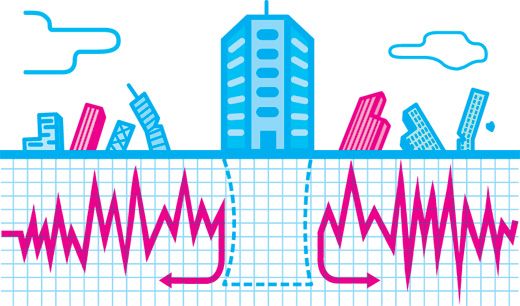How Do You Make a Building Invisible to an Earthquake?
Engineer William Parnell may have found a way to save at-risk cities from destruction
/https://tf-cmsv2-smithsonianmag-media.s3.amazonaws.com/filer/Phenom-earthquake-illustration-631.jpg)
An inventive mathematician has a new idea for protecting buildings from earthquake damage: hide them.
William Parnell, of the University of Manchester in England, suggests wrapping a building’s base, or at least key components, in specialized rubber that diverts certain temblor shock waves, leaving the building virtually untouched by them.
Parnell’s “elastodynamic cloak,” which engineers have just started testing, builds on a familiar concept: Waves headed directly for an object can be diffracted or bent so they miss it entirely. In the best-known example, scientists make objects appear invisible by encasing them within substances that have been engineered to alter the trajectory of light. When light waves pass through the cloak, they are channeled like water flowing around a rock. To an observer downstream, it appears that the light moved along a straight line, as if the object was not there.
Earthquakes are generated when two sections of the earth’s crust suddenly slip against each other along a fault line, releasing energy that ripples through the surrounding rock as seismic waves. Among the most destructive are Love waves (named after British mathematician A.E.H. Love), which move the ground side to side in a zigzagging fashion.
According to Parnell’s mathematical model, it’s possible to channel seismic waves around an object by placing it at the precise center of an underground rubber cloak. Parnell calculates that if rubber is “pre-stressed”—stretched in a specific manner—it can mimic the capabilities of light-cloaking materials.
To be sure, engineers already lay rubber shock absorbers under some buildings to protect against earthquakes. But Parnell’s cloak should prevent the structure from feeling Love waves at all. And, additional calculations indicate the cloak could potentially lessen the impact of other types of seismic waves—such as P waves, which alternately compress and stretch rock as they move through the ground.
While it may not be practical to surround whole buildings with rubber rings, cloaks could be placed around pilings or important electrical components. “Earthquake damage is not necessarily just caused by buildings falling down, but also by fires caused by electrical problems,” Parnell says.
The earthquake cloak will be put to the test by engineers Biswajit Banerjee and Emilio Calius at Industrial Research Limited in New Zealand. They plan to create a pre-stressed region around a hole in a circular slab of rubber-like silicon. Then they’ll measure whether vibrations are diverted around the hole.
Even if successful, Calius says, it will be many years before engineers could conceivably construct a building-size cloak. Still, if stressed rubber proves its worth, it might lend itself to other applications, such as soundproofing buildings from outside street noise. “Beyond invisibility,” says Calius, “cloaking technology has profound implications for everyday life.”
